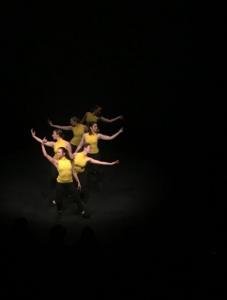
Dec 8, 2017 | News |
By Gwen Baker, Contributing Writer
Bust-A-Move Beavers (BAM), a student-led dance group, after a lot of hard work this semester, recently held one of their biannual showcases.
The lights dimmed low as dancers dressed in black and yellow with their hair tied neatly in a ponytail waited eagerly in sitting positions, backs turned away from the audience. The crowd held their breath as the song Black and Gold by Sam Sparro started, cueing the dancers to begin.

Performers dancing to Black and Gold, Choreographed by Rachael Chavarie. (Photo Courtesy of Gwen Baker)
Rachael Chavarie, a junior Elementary Education major and Vice-President of the club, choreographed this routine. Chavarie chose Black and Gold because it sounded like something she had never heard before. “I discovered the song in my favorite movie, Fame, and I just really love it.”
Zyanya Holman, a junior majoring in Community Health, has been attending BAM recitals every semester since her freshman year to support her friends, including Chavarie. Holman loved everything about Chavarie’s performance in Black and Gold. “It was very sassy, very spicy,” said Holman. “It felt like you wanted to get out of your seat and join them.”
One of the performers in Chavarie’s routine was the current club President Meagan Ring, a senior double majoring in Math and Actuarial Science. Ring choreographed the routine for She Used to Be Mine, by Sara Bareilles.
“One of my favorite [routines] to perform was She Used to Be Mine because it is really meaningful and hits home for a lot of people,” explained Ring. “I wanted to use it to bring some awareness to domestic violence.”
Another popular performance was “Inner Demons” by Julia Brennan, a duet choreographed by Autumn Hopkins and Meagan Ring. “I loved, loved, loved “Inner Demons”, it was very graceful, very powerful,” said Holman. “It sends a message of strength and overpassing obstacles.”
Ring describes the dynamic of BAM as a close group of people who share the same passions with one another. “We call each other a Bamily; we’re a family. A little spin on family,” said Ring with a fond smile.
“BAM is awesome, it’s so much fun, we are a great group of people,” laughs Chavarie. “[However], we can get silly sometimes.”
If you are interested in joining BAM, search for “UMF Bust-A-Move Beavers” on Facebook.
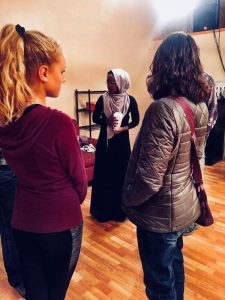
Nov 18, 2017 | News |
By Gwen Baker – Contributing Writer
A diverse group of Farmington community members came together at UMF to hold a vigil for the victims of a truck bombing in Mogadishu Somalia.
After hearing about this news, Mana Mohamed, a senior majoring in Political Science and minoring in International and Global Studies, felt compelled to do something about it.

With a large community of Somali students attending UMF, many were directly impacted by this news. Mohamed felt it was disheartening that so many were uninformed about such a big event.
“It felt like it was on me to remember them if no one else was willing to do it,” said Mohamed. She organized a vigil to inform others of what was happening and to rightfully honor the victims of the attack.
“The purpose of [the vigil] was to stand in solidarity with the people who lost their lives in the bombing and also to let the students affected know that we stand in solidarity with them,” said Sitey Mutkar, a senior Pre-Med major and friend of Mohamed’s.
Mohamed did not expect many to attend the vigil, but she was pleasantly surprised to find 30 people in attendance, including UMF students, faculty and high school students. Mohamed ran most of the event but offered others who felt obligated the chance to speak. Linda Beck, one of the professors in attendance, was grateful there was a safe space being offered for the victims.
Mutkar spoke about how she was directly affected by this act of terrorism. “My first cousin, who was attending the university there, was amongst the people who died in the bombing,” she said.
While the person responsible for the attack’s intention was to target parliament members, the bomb was placed near a tank, causing it to explode and intensifying the blast. Many students and children were amongst those who were killed, with over 300 people injured with and the death toll rising to over 500.
Mohamed emphasized the importance of not picking and choosing who to remember. “I think it’s incredibly important that we don’t become blind and choose which people to remember and which people we ignore,” she said. “Every death impacts somebody in this world. It’s making someone hurt, it’s making someone incredibly hard to live by.”
Oct 27, 2017 | News |
By Gwen Baker – Contributing Writer
Over 70 bodies were squeezed into The Landing like moviegoers on opening night as people waited for Kelly-Anne Rush to speak about her experiences as a teacher. Dressed in a black and white striped dress with a cardigan on and an honest but positive attitude, Rush gave hope to the aspiring educators in the room.
Currently, a social studies teacher at Windham High School, Rush started by telling a story of what inspired her to become a teacher, dating all the way back to elementary school. Her second-grade teacher, Mrs. Rich, saw something in her that she didn’t yet know at eight years old. When Rush wanted to be in the ensemble for the class play Little Bunny Sue, Rich said to her, “you know what? I think you should be Little Bunny Sue.” Although Rush did not believe she could do it, Mrs. Rich assured her that she had confidence in her.
Rush then discussed overcoming challenges students may face after graduating from college. She explained how she paid off her student loans by becoming a professional live-in nanny through the agency Beacon Hill Nannies outside of Boston for a year.
Rush wasn’t always at Windham High School; she first started teaching at Lake Region High School as a long-term sub, which turned into eight years of teaching there. While she had strong relationships with students and colleagues, she emphasized going out of your comfort zone in order to grow.
Her transition to Windham High School wasn’t the easiest. Halfway into her first day at WHS, she cried in the teacher’s room. She told the audience, “I did not anticipate the feeling I would have of not having any connections to any students.” While this was a low point in Rush’s life, she told this story to show that there are going to be days, months and years where work isn’t going to be easy.
She also discussed how to juggle finances on a teacher’s salary. Going into her sixth year at WHS, she has picked up different stipend positions at the school over the years such as homecoming coordinator and class advisor. Outside of school, she sells clothes on consignment and refinishes furniture found at Goodwill, Poshmark and Salvation Army. She also flips several houses to earn extra money. In the past, she owned a photography business during the summer.
She showed the audience her teaching blog that she created. It has teaching resources for ways to help stay organized in the classroom. She discussed the power of social media and how her website has become popular amongst the teaching community. One of her posts has been viewed 250,000 times.
Rush’s ability to connect with the audience and add humor allowed others to feel at ease going into the teaching profession. “I really appreciate that was she was honest about the fact that the profession isn’t always easy,” said Jacqueline Gleason Biore, a sophomore majoring in Secondary Education English and French. “She was preparing us well for what we might experience. It will be hard sometimes but that doesn’t mean you should quit because it can be hard for everyone.”
Rush offered advice to anyone struggling with the responsibilities of being an educator. “Stay true to who you are as a teacher and really try to build relationships, eventually you’re going to feel great there and comfortable.”

Oct 13, 2017 | Feature |
By Devin Lachapelle – Contributing Writer
As the fall semester nears its midpoint, student-athletes at UMF say that they’re able to balance demanding coursework with busy sports schedules thanks to hard work, effective time management and the help of friends and coaches.
Gwen Baker, a junior and member of the women’s cross country team, said that strong time management skills are extremely important for student-athletes given their often-crowded schedules.
“I like to joke that I don’t exist on Tuesdays; I’m busy from 5:30 a.m. to 7:00 p.m., with only a small break in the afternoon,” she said with a laugh. Baker then said, “It’s been a process to learn how to be organized as an athlete. I’ve been very organized because I’ve had to be.”
Michael Pingree, also a junior and a goalkeeper for the men’s soccer team, said that student-athletes often have to make difficult decisions in an effort to not get behind on schoolwork.
“You have to make tough choices and say no,” he said, “whether it be going out of town or going out one night, just because you have a game the next morning.”
Pingree stressed the importance of having a supportive group of friends to help stay motivated. “During the season, you have to have a friend group to keep everything balanced,” Pingree said. “You can really burn yourself out. To have a peer group that you can talk to about it or hang out with really helps.”
Junior and field hockey player Chelsea Ballard mentioned that her game schedule occasionally interferes with her classes. “Sometimes if I have a game on a Tuesday or Thursday night I’ll miss my Social Studies Methods class. We often leave early [for games], so I would miss my Public Writing class as well,” she said.
Ballard went on to describe the steps student-athletes have to take before any planned absences can take place. “Our coach has to sign off on a letter that tells the professor why we’re missing,” Ballard said. “Still, some professors don’t like it when we miss class.”
Ballard, like Baker, credits organization as the key to academic success for students with limited free time. “[Field hockey] takes away from my homework time,” she said. “Being both a student and an athlete, I have learned extremely good time management skills. I’m often going from one thing to another so I have to make sure I have everything organized and set up so I can make the smooth transition.”
Baker, whose athletic schedule also conflicts with her school schedule, stated that while her coaches try to maintain consistent practice times that work for most students, the coaches are flexible and do not penalize players when they do have to miss practice because of classes.

Gwen Baker (Left) competes against an opponent from Saint Josephs College (Right) during the UMF Invitational at Mt Blue High School in early September. (Photo Courtesy of C.J. Jenkins)
“Practice is at 3:45, which is usually a happy medium for everyone. I can’t run until after practice because I have Journalism then,” Baker said. “Coach knows I’ll still do the workout on my own.”
Moninda Marube, an assistant cross country coach at UMF since fall of 2016, agreed that coaches try to adapt to the needs of individual students.
“We work with their professors to ensure that classes do not fall on our training schedule or if they do, we always figure out how a student would best get their workout without missing a class.”
Marube emphasized that the key to academic and sports success was having players trust and support one another. “We have not had cases of students burning out yet,” he said. “We have caring team members who always seek to help each other to stand strong in their weak points.” Marube continued, “We have a great team chemistry and we address each member of our team at a personal level.”
Pingree and Baker both cited physical fatigue as a consistent challenge for student-athletes. Pingree said, “The biggest thing is how tired you are every day. You get home from practice, make dinner, shower, and by that time it’s already 7:00. The physical amount of preparation that goes into [sports] is the hardest thing for people to realize.” Baker said, “I’m usually exhausted coming home from weekend meets.”
Chris Strople, an Assistant Professor of Education at UMF, is the academic advisor to several varsity athletes. Professor Strople noted that student-athletes can be at risk of getting overwhelmed.
“Getting burned out by the high workload is certainly a concern,” he said. “I emphasize the importance of maintaining a balance . . . That balance is not universally achieved and so it often will be different depending on the person.”
Professor Strople, a former Division I water polo player at Loyola Marymount University, noted how important it is for student-athletes to have a support system in place. “I do have first-hand experience with the challenge of balancing the responsibilities of both athletics and academics . . . It’s not easy for anyone with the challenge of finding a balance between the two, so I would encourage them to communicate with their teammates, coaches, classmates, and professors for support when needed,” he said.
Baker, Pingree, Ballard, and Professor Strople all agreed that, despite the challenges faced by student-athletes, the connections made are well worth the effort.
“It’s not always about winning or losing,” said Professor Strople, “but often about the friendships built while working toward a collective goal.”
The women’s cross country team heads to Colby College for a meet on Friday, Oct. 6th at 4:00. A day later, the field hockey team will face off against New England College at 2:00 and the men’s soccer team will battle Green Mountain College at 3:30, both at home.
For more detailed information about the fall sports schedules, including schedules of sports not listed here, visit http://athletics.umf.maine.edu/landing/index.
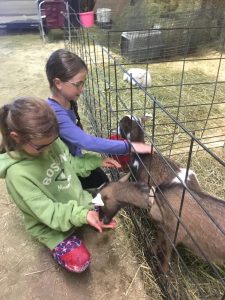
Oct 13, 2017 | Feature |
By Gwen Baker – Contributing Writer
For many people at the Farmington Fair, the animals are an instant attraction. Fairgoers get to see a wide range of unique animals such as goats, cows and ducks.

Scout and Summit with their mother
(Scout: 8 years, top in purple and Summit: 7 years, bottom in green)
“What’s your name?”
“S-C-O-U-T,” replies Scout.
“And what’s your name sweetheart?”
“Summit.”
“How old are you two?”
“I’m eight,” says Scout
“Seven,” says Summit.
“Why are you drawn to the goats?”
“Cuz they’re cute and fluffy,” says Scout.
“And they’re lickable,” laughs Summit.
“Not likeable, but lickable?” asks their Mother.
“And they’re all different,” Scout adds.
“Do you guys go to the Farmington Fair every year?”
“We don’t come every year, as much as we can,” said their mother. “We live in Livermore.” The mother and the two girls moved down the enclosure to another group of goats.
“These guys like you better,” she said. The goats move towards the girls, sticking their heads through the wire. Both the girls kneel down and began patting the goats through the fence.
“Easy Summit they bite,” her mother advised.
“I know,” she replied.

Becca Beatty
(UMF student Becca Beatty poses with cow)
“Why do you like cows?”
“I first realized how awesome cows were on a family vacation to a farm in NH. I watched a baby cow get born and I also got to milk a cow. I asked my mom if we could get a cow and she said no! Every year during fair season, I try to convince her to let me buy a cow. If I were to buy a cow I would want it to be like a pet dog, it would live inside with me, but I don’t think I would fit inside my apartment. They’re like big dogs and I like dogs… and they lick my face.” She pointed to a baby cow. “I wouldn’t have space for a full grown cow, but possibly a baby. I could fit that size into my apartment. My mom however would not be impressed.” The cow started to lick her face. Laughing hysterically, she told it to stay still so it could pose for the camera. “It’s licking my face… It feels like a cat’s tongue only pricklier,” giggled Beatty.
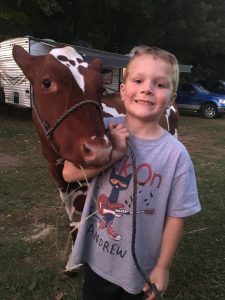
Andrew with Mother Lilly Bagley
(Andrew, age 8 years with Georgia)
“How long have you had the cows and what are their names and breed?”
“We’ve grown up with dairy cattle. It’s kinda our passion,” explained Lilly Bagley. “So we have three Milking Shorthorn and one Ayrshire. And we’ve had them for about two years now,” said Bagley. Pointing towards the fence where the four cows were, she began describing the cows.
“I have Rhonda to the left, and Georgia on the right of the pen. And then I have Gargamel, like from the Smurf Gargamel; she’s the brown one and Frozen, (far right) she’s considered a roan, the coloration of her is considered roan.”
4-H is a program that children from 5-18 can participate in and be involved in different projects, from agriculture to arts and crafts to robotics. Most clubs meet once a month and discuss business and come up with plans that members can do in their project.
“My oldest son [Jason] is able to be in 4-H now so he’s able to work with his own animals,” said Bagley. “My husband and I grew up with dairy cattle, went to college and kinda got out of it, then went back into it when the kids were old enough. He’s [Andrew] almost old enough.”
“To participate in 4h, they have to be nine. And then they do little classes for kids five to eight,” said Bagley.
“My favorite thing about raising dairy cattle is the bond that you form between each animal and that each heifer has its own personality.”
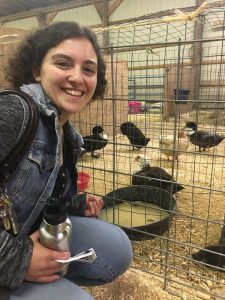
UMF student Elina Shapiro
(Elina Shapiro with Muscovy duck)
“Tell me a little bit about why you like birds?”
“I really have liked birds ever since I took Ornithology my freshman year in college. I took it actually in North Carolina, where I grew up, and ever since I took the class I fell in love with birds,” Shapiro reminisced.
“I’m an avid bird watcher and I love their diversity. I love seeing all the different kinds of birds while I’m out there and though I’d much prefer being out in the field and seeing birds, a lot of the birds that are in here, I have seen in the field.”
She pointed to the duck next to her. “One of which, one of the birds in here called the Muscovy duck was actually very prevalent right near my house and at the campus, I was at where I took Ornithology. It looks kind of funny, so every time I see it, it brings humor I guess you could say. It looks kinda like a combination of a chicken and turkey with warts. I mean it just looks very strange,” Shapiro laughed.
“I love bird watching. I also did a lot of bluebird research for two summers. So bluebirds are my favorite. I wouldn’t call that one my favorite [Muscovy duck], but it brings humor because it looks so funny,” said Shapiro.
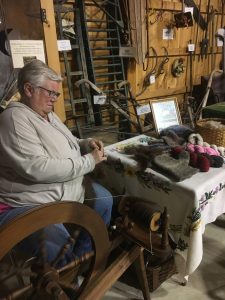
Diane Bolduc spins alpaca yarn on the machine.
“How long have you been spinning?”
“[I’ve been spinning for] twenty-seven years, I’ve been coming [to the Farmington Fair] for thirteen,” said Bolduc.
“What is the process of spinning, how does the machine work?”
“The process is shearing from a sheep or an alpaca, washing and carting it, combing it, then spinning it. I decide how thick or thin I want my yarn to be by thinning it out here. I pull it and thin it out and the spinning wheel twists it. All the spinning wheel does it twist it, and when I’m ready, I let it go. It runs through, it goes through the hole, comes out the others side and runs across these little hooks and winds up at the bobbin,” Bolduc replied, her hands swiftly gesticulating the movements as she demonstrates the process.
“And then when I’m all done I will apply it back on itself, which is twisting the two together, and it will be yarn ready to knit or crochet with,” said Bolduc.
“Does it take practice to get the handle of it?”
“Absolutely, it takes practice. When I first started, I was making rope. It was huge, it was thick, it was overspun. But it’s like anything, the more you do it, the better you get. The more practice. It’s a very touch feel, hands on type of activity. And once you learn how to do it, it’s like riding your bike; you have it forever.” She continued to spin, focusing on the process.
She later mentioned how children on class field trips call the sheep that are colored “Easter sheep.” as well as her amusement when men specifically ask her if they “really have sheep that color.”








